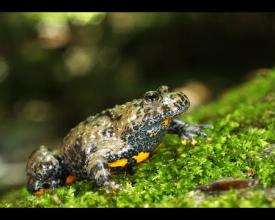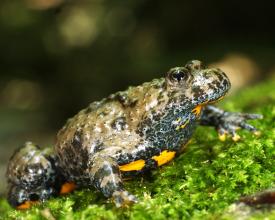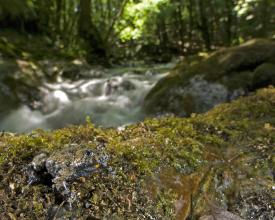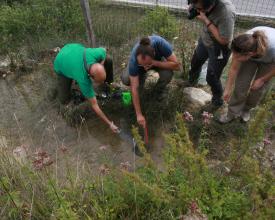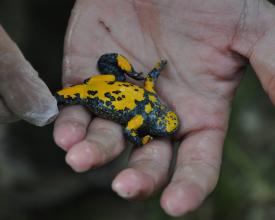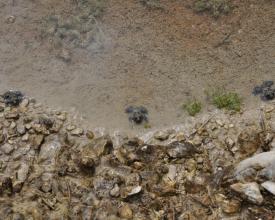
Conservation of Apennine yellow-bellied toad
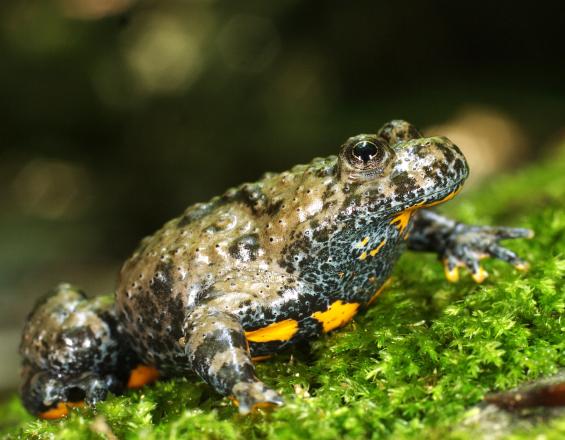
The Apennine yellow-bellied toad (Bombina pachypus) is an amphibian endemic to Italy listed as Endangered by IUCN RedList.
Most populations are reduced to 6-20 individuals.
We report a restocking project in two demes that suffered dramatic declines with population size <10 individuals.
The threats for the species at the study sites were pool desiccation and habitat alteration by Wild boars.
Populations size remained stable in 2005-2013. In 2012, two actions were implemented to mitigate the threats: 1) additional pools were built and fed by springs to avoid desiccation; 2) each pool was fenced to prevent Wild boars from using the pools. After two years, no population growth was observed.
We started a four-year (2014-2017) project aimed at increasing the population size through restocking of individuals raised in ex-situ facilities. Overall, 67 young toads were released.
Context
Challenges addressed
The main objective of the project is to develop a conservation strategy at the local level involving as the main partners the Monti Navegna e Cervia Nature Reserve, the Fondazione Bioparco of Rome and the Department of Science of the University of Roma Tre. In detail, the project aims to address the following challenges:
1 Mitigate the main threats to select demes before restocking: e.g. early drought of pools and alteration of wetlands by wild boar (Sus scrofa).
2 Producing an adequate captive-bred population of one-year-old metamorphosed individuals from eggs collected in the wild from the same site selected for restocking.
4 Release captive-reared one-year-old toads into the wild in four annual restocking events from 2014-2017.
5 Doubling (at least) the original population (i.e. N>20) after the fourth year of restocking.
6 Establish two long-term self-sustainable populations of Bombina pachypus
Location
Process
Summary of the process
The connection and interaction among building blocks is sequential. Each block is preparatory for the following one and cannot ignore the realization of the previous one so that the entire project is fully successful.
Monitoring the conservation status of Apennine yellow-bellied toad populations is essential for planning threat mitigation actions. In turn, the impact of mitigation actions must be evaluated over time to understand if there is a need for further reinforcement actions (restocking).
Building Blocks
Pre-action monitoring
Pre-action monitoring activity is needed to define the baseline and quantify the impact of the distinct tasks of the project on the conservation status of the targeted species. In our case, the two study populations were monitored by capture-mark-recapture method from 2005 to 2013. We assessed a population size of 18 individuals (nine per deme) that remained stable with only three new individuals entering the population in nine years of monitoring. Each site consisted of one or two small ephemeral pools where the toads spawned from late March to late September
Enabling factors
Pre-action monitoring should be defined prior the begining of the project. Monitoring must consist of standardized methodologies (i.e. same effort and approach), thus enabling replicability along time and space, that allow a quantification of selected metric that in turn allows to quantify the impact of the concrete conservation actions
Lesson learned
Our pre-action monitoring was performed by the same staff during the entire course of the of project. This means same effort and efficiency and reduces the inconsistencies among samplings and years.
Threat Mitigation
Before any concrete conservation action that involve traslocation of individuals (with or without ex-situ reproduction) an assessment of the occurring threats and their mitigation/eradication is mandatory for the success of the actions.
Since the main threats observed for the species at the study site were the high risk of pond desiccation in the early stage of the breeding season (i.e., June) and alteration of the ponds by wild boars, two main conservation actions were carried out in 2012 to mitigate them:
- four additional pools at each site fed by perennial springs were constructed to extend the hydro period from March to October;
- each puddle was fenced to prevent wild boars from using them for drinking and bathing.
Enabling factors
A thorough knowledge of the species biology and ecology is needed to exhaustively uncover and depict the effective and potential threats acting and impacting the conservation status of the target species.
Lesson learned
The mitigation / eradication of the main threats that impact the conservation of the target populations may be insufficient to achieve a significant impact (i.e. a reversal of the negative trend) in the short / medium term. It is possible that mitigation actions must be coupled with concrete conservation interventions that involve the translocation of individuals to increase the size of populations in the short term. The possibility of not observing impacts from threat mitigation actions in the short term is more likely if the target species is long-lived and has long generation rates. In fact, Bombina pachypus is a long-lived species, being able to reach about 30 years of age.
Restocking
Since no population increase has been observed two years after the threat mitigation actions, in 2014 we launched a four-year restocking project aimed at increasing the population size.
The project involves the collection in the wild of a fraction (30-40%) of Bombina pachypus population at the egg stage, their development in captivity and the subsequent release of metamorphs in the same site of collection.
All the ex-situ management of toads was implemented at Fondazione Bioparco facilities where individuals were kept until the ventral coloration pattern is fully defined so that they can be photographically marked for future identification and demographic studies in the wild.
Overall, 67 young individuals were released (20 in 2014, 19 in 2015, 16 in 2016 and 12 in 2017).
Post-release monitoring revealed that the toad recapture rate was highly variable over the years. In 2018, we re-captured a total of 21 individuals: 10 released in 2014, two in 2015, four in 2016 and five in 2017. The pristine population remained stable (13 individuals) with few new animals recruited and some losses. At the end of 2018, a net increase of 21 individuals released plus some from natural recruitment allowed the original population size to double.
Enabling factors
The production of individuals one year old from the egg stage requires adequate facilities and a high commitment of personnel.
Monitoring the success of restocking needs a multi-year project and adequate effort (personnel and economic).
Lesson learned
The release of metamorph individuals close to sexual maturity allowed individual recognition by ventral coloration pattern and should have significantly decreased the mortality rate that is known to peak at the egg and larval stages.
Toads bred in captivity can be used for the restocking of declining populations of Bombina pachypus.
Restocking should be done by releasing individuals in distinct phases along a multi-year project to overcome possible failure due to stochastic or unpredictable events.
The identification of the true causes behind the high inter-annual variability in the individual recapture rate and the failure to recapture many released animals (e.g. death or dispersal) can be very difficult, even at the local scale and with a high sampling effort.
Impacts
The main positive impact of our solution is represented by a net increment of 21 released toads plus some from natural recruitment that allowed to double the original population size.
Moreover, the restocked toads bred repeatedly over the years and captive-bred individual were ready to breed just after 13 months, well before the reported age at maturity for wild animals (three years). Considering the
positive outcome of the restocking of the captive bred population, the release of further individuals in the considered demes was stopped but the monitoring is still ongoing.
Given the success of the restocking action, a new larger wetlands was built in an area close to the two previously implemented. Monitoring is still ongoing.
Beneficiaries
The Nature Reserve derives a net benefit from conservation actions on a threatened species.
The citizens of the municipalities bordering the intervention area have been involved in communication and education events.

